Bid adjustments
Adjustments allow advertisers to raise or lower a bid, CPA, or conversion value for specific ad serving criteria. The values can be adjusted using coefficients. A coefficient is a percentage by which a bid, CPA, or conversion value changes (depending on the chosen strategy).
|
| Video tutorial.Bid adjustments for retargeting Watch video |
|
| Video tutorial.Bid adjustments for retargeting Watch video |
How adjustments work
Use adjustments to change the bid, CPA, or conversion value depending on user characteristics, ad format, and other criteria.
Here are the ways you can adjust bids:
- Target audience — increase or decrease for an audience that matches certain retargeting list conditions. For example, when ads are served to users who have already ordered products from your site, the bid is automatically adjusted by the coefficient (percentage) you have set.
- Gender and age — increase or decrease for an audience of a particular gender or age.
- Video — increase or decrease for ads with videos.
- Display region — increase or decrease for ad display regions.
Smart ads — increase or decrease for smart ads. Only for smart banners.
- Devices — increase or decrease for different types of devices.
- Inventory — increase or decrease for different types of display advertising. Available only for display campaigns.
- Weather — increase or decrease depending on weather conditions.
- Exclusive placement — an increase for exclusive placement or ads in autofill suggestions.
- Income — increase or decrease for high-income segment.
- Adjustment of CPA, cost revenue ratio, or CPC — increase or decrease for the user acquisition cost in a specific group of a unified performance campaign.
You can adjust bids for a particular campaign or ad group. If you use the same type of bid adjustment both at the campaign and ad group level, the group-level adjustment will be used.
If you don't want to apply adjustments to a certain ad group within a campaign, set the coefficient for that group to zero.
-
For example, let's say you set the coefficient to “increase by 40%” for a particular campaign, but you don't want this coefficient to apply to a particular ad group. For that group, you would set the coefficient to “0%”.
With the “Maximum number of clicks” strategy, your campaign will maintain an average CPC after accounting for adjustments but won't exceed the weekly budget limit.
-
For example, you're using a strategy with a maximum bid of 20 rubles per click, and your coefficient for mobile impressions is set to “increase by 100%” (so that the adjusted bid is 40 rubles). In this case, impressions on mobile devices will be served at the 40 rubles bid rate.
In conversion-based strategies (Maximum conversions, Maximum conversions with a ROI limit), the goal values are maintained based on these adjustments.
-
For example, you use the “Maximum conversions” strategy and specify an average CPA of 200 rubles. You also increase the bid by 100% for smartphones. In this case, the average CPA will be 400 rubles for smartphones and 200 rubles for other devices. If you enable payment per conversion, with settings and CPA similar to 200 rubles, you'll be charged 400 rubles per conversion on a smartphone.
If you use the “Maximum conversions” strategy capped only by the weekly budget (with no average CPA) and add an increase adjustment of 100% for smartphones, then the bid can be increased twofold when serving ads on mobile devices. In this case, the strategy will try to maintain the specified weekly budget.
In the Maximum conversions strategy limited by the cost revenue ratio or ROI, the adjustments will affect the target cost revenue ratio or ROI maintained by the strategy for the selected cross section.
-
For example, if the increase adjustment is set to 100% for smartphones and the cost revenue ratio is 10%, the strategy will maintain a 20% cost revenue ratio for smartphones and 10% for other devices. If you enable payment per conversion, the strategy will bring you conversions at a fixed cost corresponding to the preset cost revenue ratio, with the adjustments taken into account.
Using multiple adjustments
You can apply several adjustments to a given bid, CPA, or conversion value (for mobile impressions, by gender and age, by display region, by time of day, and others). Adjustments are applied in succession (they aren't combined).
- The table shows an example of how the bid is calculated if the bid on a display condition is 15 rubles and the bid adjustment is the following:
- For men aged 18–24: “Decrease the bid by 40%”, which means 100% − 40% = 60% of the bid (or bid × 0.6).
- For women aged 25–34: “Increase the bid by 60%”, which means 100% + 60% = 160% of the bid (or bid × 1.6).
- For impressions on mobile devices: “Increase the bid by 30%”, which means 100% + 30% = 130% of the bid (or bid × 1.3).
- For Moscow and the Moscow region: “Increase the bid by 200%”, which means 100% + 200% = 300% of the bid (or bid × 3).
Gender and age Mobile Display region Bid Men aged 18–24 Women aged 25–34 Moscow and the region Men aged 18–24 + Desktop + Moscow 



15 × 0.6 × 3 = 27 rubles Women aged 18–24 + Desktop + Yekaterinburg 



15 rubles Women aged 25–34 + Mobile + Moscow 



15 × 1.6 × 1.3 × 3 = 93.6 rubles Gender and age Mobile Display region Bid Men aged 18–24 Women aged 25–34 Moscow and the region Men aged 18–24 + Desktop + Moscow 



15 × 0.6 × 3 = 27 rubles Women aged 18–24 + Desktop + Yekaterinburg 



15 rubles Women aged 25–34 + Mobile + Moscow 



15 × 1.6 × 1.3 × 3 = 93.6 rubles
Add bid adjustments and coefficients
You can add adjustments on the following pages:
- Ad group edit page: in the Adjustments section.
- Campaign settings: Under Advanced settings, go to Adjustments.
Click on the name of a bid adjustment to read more about it:
You can set bid adjustments for specific retargeting lists.
- For example, let's say some users on your site put items in their shopping carts but did not end up purchasing them. You can add an adjustment based on the “Put items in their cart” condition and set an increase coefficient. This way you'll increase the probability of reaching an audience that's interested in your product.
You can set up a retargeting list on the page where you edit ad groups in Retargeting & Audiences.
Select a retargeting list and set a coefficient. To add a bid adjustment, click New adjustment (maximum of 100 adjustments in total). Above the adjustment list, you can assign the same coefficient for all conditions.
The adjustment can range from −100% (in this case, impressions are disabled) to +1200% of the bid, CPA, or conversion value.
-
For example, if a keyword is assigned a bid of 40 rubles and the increase adjustment is 1000%, the actual bid is 440 rubles.
Please note that sometimes ads may be served to users based on a condition that you disabled using bid adjustments (that is, you set the "decrease by 100%" coefficient).
If the user meets multiple adjustment criteria, an adjustment with the maximum increase coefficient among them is applied.
If your target audience consists of users of one gender or age group, you should use adjustments that match these characteristics. You can use cross sections of gender and age statistics found in Report Wizard, as well as demographic reports from Yandex Metrica to help determine your audience composition.
-
For example, let's say that almost all customers who buy cosmetics from your online store are women around 30 years of age. You can set your gender and age criteria and apply the bid adjustment to “increase by 120%” so that your ads are more frequently served in favorable positions to women aged 25–34.
Choose your target gender and age and set the adjustment coefficient. To add a bid adjustment, click New adjustment (maximum of 12 adjustments total). Above the adjustment list, you can assign the same coefficient for all conditions.
The All field includes men, women, and users whose gender could not be determined. The Any field includes users of all ages including those whose age could not be determined.
The adjustment can range from −100% (in this case, impressions are disabled) to +1200% of the bid, CPA, or conversion value.
Please note that sometimes ads may be served to those users that you have excluded from targeting using the adjustments for age and gender.
In “Text & Image ads” campaigns, you can experiment with adjustments to get the desired number of click-throughs from videos. You can't disable impressions for videos completely.
Adjustments can range from −50% to +1200% of the bid, CPA, or conversion value.
-
For example, if a keyword is assigned a bid of 40 rubles and the increase adjustment is 1000%, the actual bid is 440 rubles.
To disable bid adjustments, enter a value of “0%” or delete the value.
Advertisers can use regional adjustments to increase or decrease the bid, CPA, or conversion value when serving ads to users in specific areas. Yandex Metrica reports can help you determine the best adjustments and the best times to use them.
Regional adjustments can be set at the campaign level, but not at the ad group level. To set them up, go to adjustments for the display region in the campaign settings and set coefficients for the relevant regions.
The adjustment is applied to the selected region and all its subregions, unless a separate adjustment is set for them.
The adjustment can range from −90% (in this case, impressions are disabled) to +1200% of the bid, CPA, or conversion value.
-
For example, you're using an automatic strategy with the maximum bid set to 20 rubles per click, and your coefficient for impressions in Moscow is set to “increase by 100%” (so that the adjusted bid is 40 rubles). In this case, ads for users in Moscow will display at the 40 rubles bid rate.
Regional adjustments do not affect how extended geotargeting works.
-
For example, let's say you want the keyword amusement park to trigger your ads for an amusement park in Moscow, and your bid is 20 rubles. You set a coefficient to increase your bids for ads served in Moscow by “100%” (so that the adjusted bid is 40 rubles). If extended geotargeting is enabled, then a 40 rubles bid may be used when a Moscow-based user searches for an amusement park or a user outside of Moscow searches for an amusement park in Moscow.
You can set an adjustment for smart ads (individual ads for products that are part of a “Smart banner” campaign). The adjustment will not apply to your bids and costs for other smart banner templates.
Adjustments can range from −80% to +1200% of the bid, CPA, or conversion value.
-
For example, if the bid is 40 rubles and the adjustment is set to +1000%, the actual bid is 440 rubles.
To disable bid adjustments, enter a value of “0%” or delete the value.
You can set adjustments for impressions on different types of devices. To find out which devices people use when they engage with your ads or open your website, use the Device type segment in Report Wizard and the “Technologies — Devices” report in Yandex Metrica.
- On smartphones — only on iOS, only on Android, or on all smartphones (iOS, Android, Windows, and others). In display video ads — on all smartphones only.
- On tablets — only on iOS, only on Android, or on all tablets (iOS, Android, Windows, and others). Not available for any display campaign.
- On desktops — this category includes desktop computers and laptops, Smart TVs, and other devices.
The adjustment can range from −100% (in this case, impressions are disabled) to +1200% of the bid, CPA, or conversion value. However, you can't decrease the bid by 100% for all types of devices at once.
-
For example, if a keyword is assigned a bid of 40 rubles and the increase adjustment is 1000%, the actual bid is 440 rubles.
To disable a bid adjustment, delete it or set its value to “0%”.
- Use scenarios
-
If you advertise a mobile app for iOS and want to show ads only to people who use devices running iOS, disable impressions on Android and desktops.
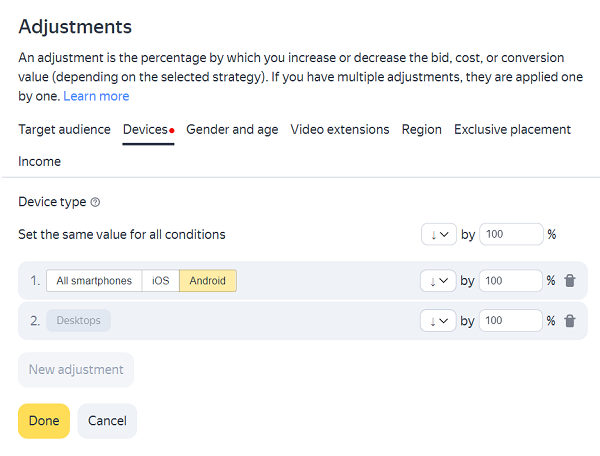
To use a special landing page for mobile devices, specify it when creating your ads and use an adjustment to disable impressions on desktops.
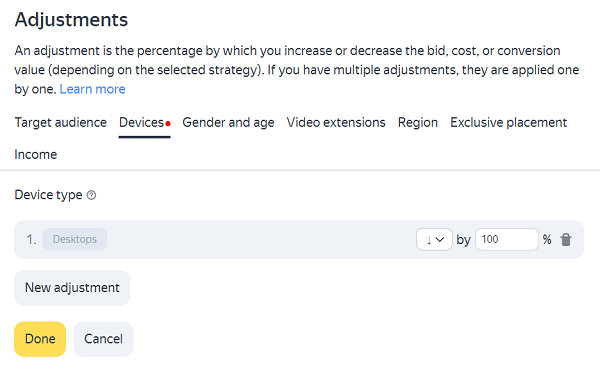
You can set adjustments for certain types of inventory in your display campaigns. Bid adjustments allow you to increase or decrease the bid for serving:
- Image and HTML5 banners of all sizes.
- Instream web video ads that are embedded in the video stream and play before, after, or in the middle of the main video.
- Inpage video ads embedded on website pages.
- Rewarded videos usually shown in game apps. The user receives an award or in-game currency for viewing such videos.
- Interstitial video ads shown in mobile apps before loading or changing content. Adjustments are only used for interstitial units.
When you set up adjustments for device types, you may sometimes receive some traffic that you restricted in the campaign settings. For example, viewing an instream video ad in an app might count in statistics as the “Applications” traffic type.
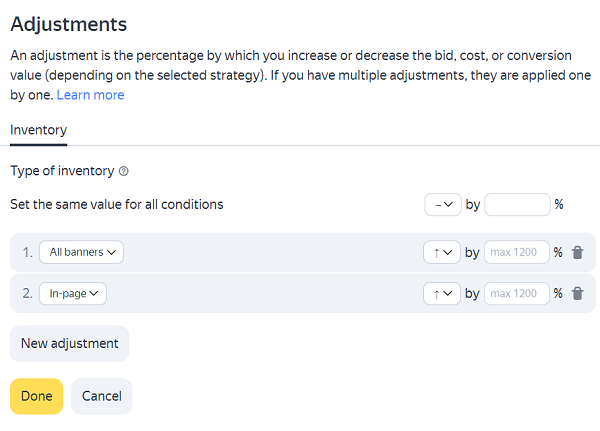
The adjustment can range from −100% (in this case, impressions are disabled) to +1200% of the bid. However, you can't decrease the bid by 100% for all types of inventory at once.
-
For example, if a keyword is assigned a bid of 40 rubles and the increase adjustment is 1000%, the actual bid is 440 rubles.
To disable bid adjustments, enter a value of “0%” or delete the value.
You can set adjustments of bids, CPA, or conversion value based on weather conditions, such as air temperature, precipitation intensity, and cloud cover.
- Increase the bid or CPA on ads for food delivery when it rains or snows.
- Advertise garden furniture only when it's sunny and warm.
- Add creatives for different products and use them depending on the weather: advertise winter clothes when it's cold and snowy, and summer clothes when it's warm and sunny.
Read more about ways to use bid adjustments.
Adjustments use data from Yandex Weather (accurate down to the hour) and are applied based on the user's region. They are available at the ad group level for display banners, Text & Image ads, and image ads.
You can specify whether all the criteria or just one of them must be met. If multiple adjustments are applicable, the adjustment with the maximum bid or CPA change is applied.
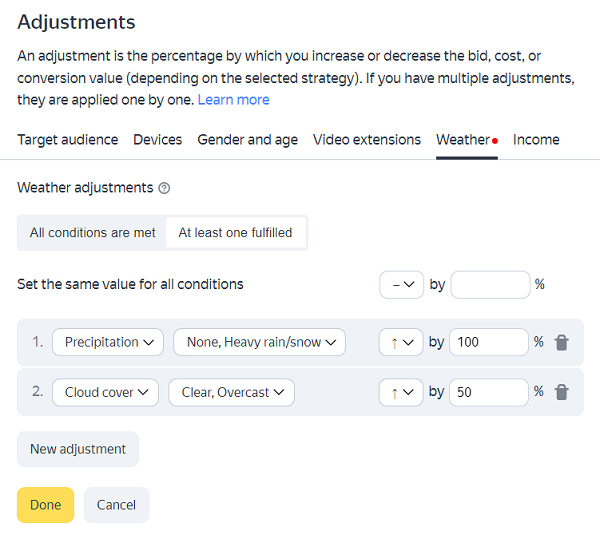
-
For example, if a keyword is assigned a bid of 40 rubles and the increase adjustment is 1000%, the actual bid is 440 rubles.
Ad design in search results is determined using SERP layouts. You can set up adjustments for bids, CPA, or conversion value for exclusive placement or ads in autofill suggestions:
Exclusive placement is the largest and most noticeable ad format in search results. An exclusive placement ad occupies a single advertising spot above the search results, bringing in about 30% more clicks.
To advertise in this format, you need to specify 8 sitelinks and their descriptions. Depending on the user's device, an exclusive placement includes up to 8 sitelinks.


Ads in autofill suggestions appear in the list of suggestions when the user enters a query in the search bar. It's available in the desktop search, mobile search, and the Yandex app. This format brings 5% more traffic, and its CTR is about 16%.

To see how often your ads receive this placement, look at the Placement type cross section in the Report Wizard. If you want your ads to get this placement more often, set a bid adjustment.
-
For example, if a keyword is assigned a bid of 40 rubles and the increase adjustment is 1000%, the actual bid is 440 rubles.
Adjustments are available for the following campaign types: “Text & Image ads”, “Dynamic ads”, and “Ads for mobile apps” at the campaign level.
The final cost per click is determined by the general VCG auction rules in Yandex Direct.
You can set up adjustments for bids, CPA, or conversion value for a high-income audience segment. The system analyzes different parameters of user behavior and assigns them to different segments reflecting their income level. The adjustments let you increase or decrease your bid, CPA, or conversion value on impressions for 10% of high-income Yandex audience split into three groups:
Top 1% (users with the highest income)
2–5%
6–10%
Adjustments for income are good for businesses whose price on products or services is higher than the market average. They are also good for companies offering premium products.
To decide if you need adjustments for income for all segments or a specific segment only, check statistics for the Income level cross section in the Report Wizard. It shows the distribution of targeted actions between users from different segments.
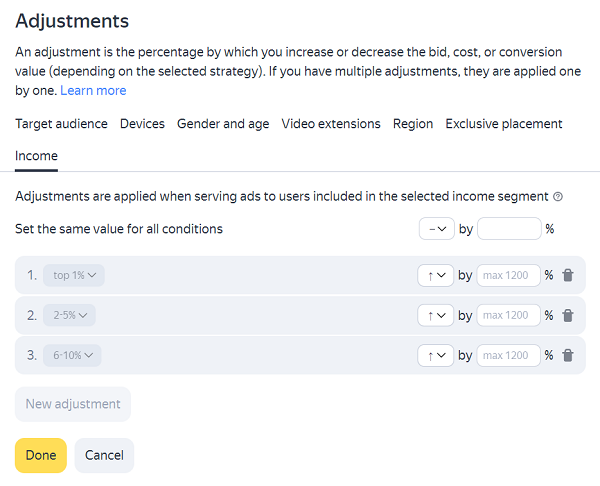
Select one, two, or all three segments and set coefficients for them. You can set the same coefficient for all conditions.
-
For example, if a keyword is assigned a bid of 60 rubles and the adjustment is set to increase by 100%, the actual bid is 120 rubles.
To disable bid adjustments, enter a value of “0%” or delete the value.
Adjustments are available for the following campaign types: “Text & Image ads”, “Dynamic ads”, and “Ads for mobile apps”, “Smart banners” at the campaign and group level.
Within a unified performance campaign, you can combine multiple groups with different targetings and ad types. The more groups you add, the more data is collected to train the strategy. In the strategy, you can specify a target customer acquisition cost (cost per conversion, cost revenue ratio, or cost per click). Keep in mind that the customer acquisition cost may be lower or higher for individual groups. For example, a group may advertise a product with a higher profit margin than the campaign average. Alternatively, the group may target regions with lower competition and fewer bidders or lower prices than in other regions.
To manage the customer acquisition cost, adjust the CPA, cost revenue ratio, or CPC for this group. The name of this option depends on the limit you selected for the strategy.
-
For example, you have a campaign that consists of three ad groups, each for its own product category: “Sofas”, “Beds”, and “Chairs”. The campaign strategy is configured to generate sales with a Cost revenue ratio (CRR) limit of 10%.
Your data shows that, on average, “Sofas” is the most profitable category of the three, so you could increase the CRR for these products up to 15%, which is 1.5 times higher than average for the other categories. In this case, you can set a “+50%” adjustment for the “Sofas” ad group.
On average, products in the “Beds” category have a lower profit margin, and their customer acquisition cost is 8% of the revenue, which is 20% less than the campaign average. Set a −20% adjustment for the “Beds” ad group.
For products in the “Chairs” category, the customer acquisition cost is about 10% of the revenue. You don't need to adjust the cost for this group.
Adjustments range between −99% and +1200% of the CPA, CPC, or cost revenue ratio. To disable a bid adjustment, delete it or set its value to “0%”.
Adjustment of CPA, cost revenue ratio, or CPC in this group applies on top of other adjustments, with their coefficients multiplied.
-
For example, in the above campaign, we added an adjustment for the display region: “+40%” for impressions in Saint Petersburg and Moscow. As a result, we get the following cost revenue ratio for these region — 1.4 × 10% = 14%.
For the “Sofas” group, when served in Moscow, the cost revenue ratio will be 14% x 1.5 = 21% because a “+50%” adjustment is set for the group.
The adjustment is only available at the ad group level.
